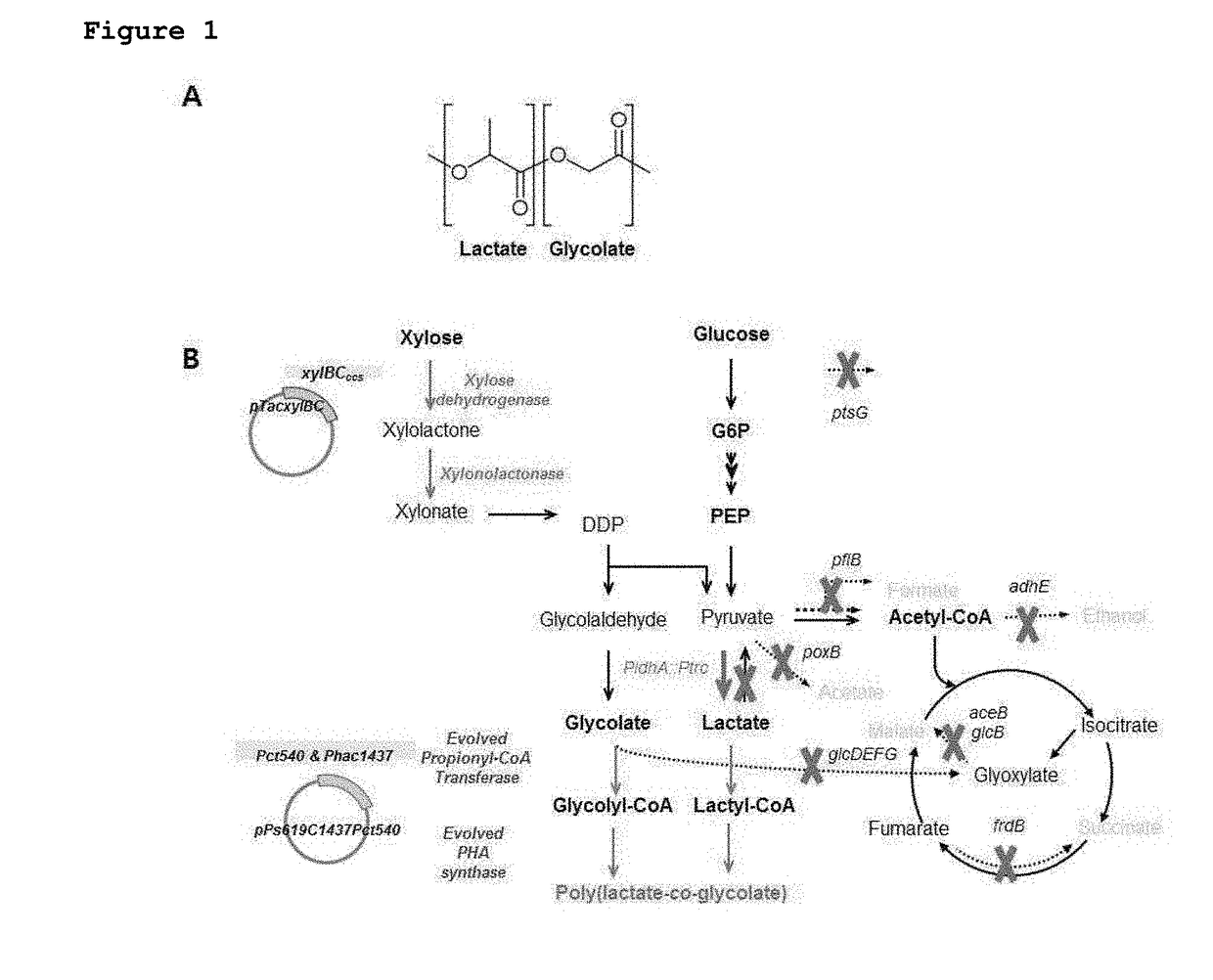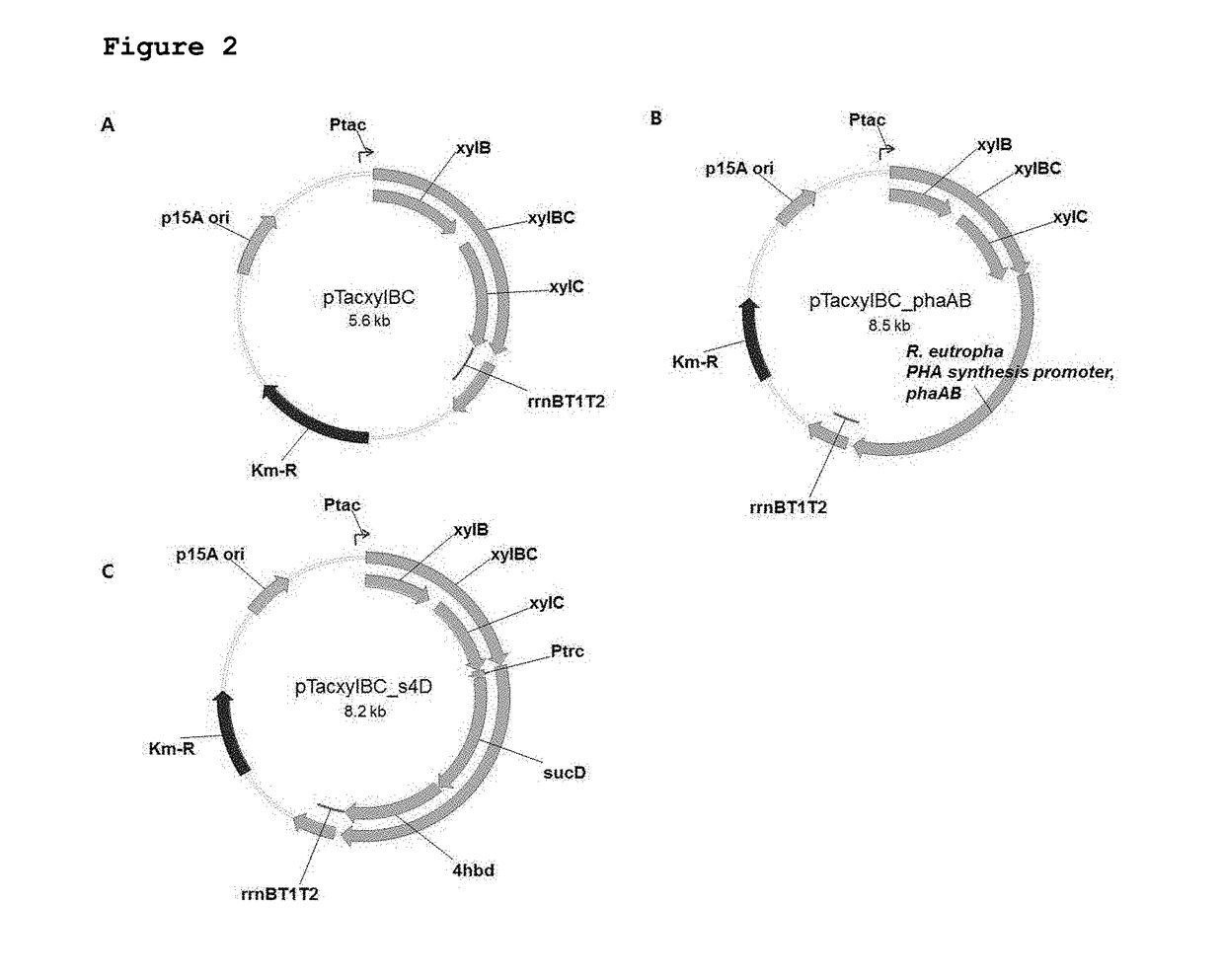Recombinant microorganism having ability to produce poly(lactate-coglycolate) or copolymer thereof from xylose and method for preparing poly(lactate-coglycolate) or copolymer thereof by using same
a technology of recombinant microorganisms and xylose, which is applied in the direction of acyltransferases, enzymology, transferases, etc., can solve the problems of difficult removal of organic solvents or chain-coupling agents, complex processing,
- Summary
- Abstract
- Description
- Claims
- Application Information
AI Technical Summary
Benefits of technology
Problems solved by technology
Method used
Image
Examples
example 1
ion of Plasmids for Genes Involved in PLGA Production, Strains, and Culture Method
[0063]The strains, plasmids and primers used in the following Examples are shown in Tables 1 and 2 below.
[0064]1-1: Construction of Plasmid pTacxylBC
[0065]Since the xylose dehydrogenase-encoding gene xylB and xylonolactonase-encoding gene xylC are present as an operon on the chromosome of a Caulobacter crescentus strain obtained from the KCTC, the xylB and xylC genes were amplified simultaneously by PCR using the xylBC_F and xylBC_R primers shown in Table 2 below, and were then cloned into a pTac15k vector (Table 1) through EcoRI and PstI restriction enzyme sites so that they could be expressed under the control of a trc promoter.
[0066]1-2: Construction of Plasmid pTacxylBC_phaAB
[0067]Using a pCnCAB vector, obtained by cloning a phaCAB operon and its promoter from Ralstonia eutropha (KCTC No. 22469), as a template, inverse PCR was performed using two primers (Pcncab_invF, and Pcncab_invR), thereby cons...
example 5
n of PLGA Having High Glycolate Content Through Additional Metabolic Engineering
[0094]In Example 4, using the recombinant X151-p and X15ld-p strains engineered from XL1-Blue, PLGA was successfully produced from xylose and glucose, but only polymers having a relatively high lactate content were produced. Thus, in order to increase of the glycolate content of the polymer, engineering for increasing intracellular glycolate production was performed (FIG. 5). To enhance the glyoxylate pathway, the malate synthase-encoding gene aceB, the glycolate oxidase-encoding gene glcDEFG and another glcB gene encoding malate synthase, which form an operon (glcDEFGB), were deleted simultaneously from the chromosomal DNA, thereby constructing a X17ld-p strain. When the X17ld-p strain expressed xylose dehydrogenase and xylonolactonase, it produced glycolate in an amount of 2.32 g / L, which was 1.6 times higher than that by the previous recombinant strain (X15ld-p), indicating that deletion of the genes ...
example 7
ion of Recombinant Microbial Strain that Produces Poly(Lactate-Co-Glycolate-Co-3-Hydrobutyrate)
[0098]3-hydroxybutyrate is the most well-known monomer of PHA, and a metabolic pathway for biosynthesis of poly-3-hydroxybutyrate was introduced in order to develop a microbial strain that produces a polymer comprising lactate, glycolate and 3-hydroxybutyrate (FIG. 7). The pTacxylBC_phaAB plasmid (Table 1), obtained by cloning the beta-ketothiolase-encoding gene phaA and acetoacetyl-CoA reductase-encoding gene phaB from R. eutropha, and the pPs619C1437Pct540 plasmid was transformed into each of the X15ld-p and X17ld-p strains. The strains were cultured in 100 mM MOPS-containing MR medium supplemented with 5 mM isoleucine for 96 hours. As a result, the recombinant E. coli X15ld-p strain produced poly(51.9 mol % lactate-co-7.3 mol % glycolate-co-40.8 mol % 3-hydroxybutyrate) at a concentration of 29.5 wt %, and the X17ld-p strain produced poly(63.3 mol % lactate-co-13.2 mol % glycolate-co-23...
PUM
| Property | Measurement | Unit |
|---|---|---|
| molecular weight | aaaaa | aaaaa |
| molecular weight | aaaaa | aaaaa |
| wavelength | aaaaa | aaaaa |
Abstract
Description
Claims
Application Information
 Login to View More
Login to View More - R&D
- Intellectual Property
- Life Sciences
- Materials
- Tech Scout
- Unparalleled Data Quality
- Higher Quality Content
- 60% Fewer Hallucinations
Browse by: Latest US Patents, China's latest patents, Technical Efficacy Thesaurus, Application Domain, Technology Topic, Popular Technical Reports.
© 2025 PatSnap. All rights reserved.Legal|Privacy policy|Modern Slavery Act Transparency Statement|Sitemap|About US| Contact US: help@patsnap.com



